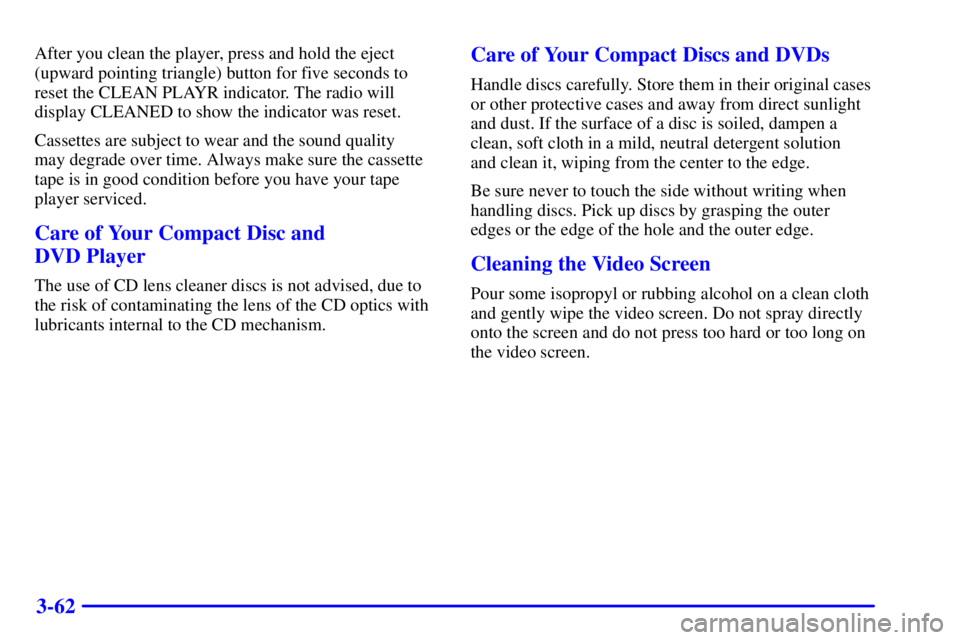Page 224 of 429

3-57 Rear Seat Audio (If Equipped)
This feature allows rear seat passengers to listen to any
of the music sources including AM
-FM, cassette tapes
or CDs and to use automatic tone control. The rear
seat passengers can only control the music sources
that the front seat passengers are not listening to.
For example, rear seat passengers may listen to a
cassette tape or CD through headphones while the
driver listens to the radio through the front speakers. The rear seat passengers have control of the volume for
each set of headphones. The front seat audio controls
always override the rear seat audio controls.
This feature is intended for rear seat passengers.
The following functions are controlled by the rear seat
audio system buttons:
VOL: Turn the knob clockwise to increase volume
and counterclockwise to decrease volume. The left VOL
knob controls the left headphone and the right VOL
knob controls the right headphone.
PROG: With a cassette tape in the player and the
radio playing, press this button to play a cassette tape.
Press PROG to switch between the tape and compact
disc if both are loaded. Press PROG again to return
to the radio when a cassette tape or compact disc is
playing. The inactive tape or CD will remain safely
inside the radio for future listening.
PWR: Press this button to turn the rear seat audio
system on or off. The rear speakers will be muted
when the power is turned on unless you have a Bose
�
equipped vehicle. You may operate the rear seat audio
functions even when the primary radio power is off.
Page 226 of 429

3-59 Audio Steering Wheel Controls
(If Equipped)
If your vehicle has this
feature, certain radio
functions can be operated
by using the controls on
your steering wheel.
AM/FM: Press this control to tune to the next radio
station. When playing a cassette tape or compact disc,
press AM/FM to switch to the radio.
(Program): Press this control to tune to a higher
preset radio station. When playing a cassette tape, press
program to hear the other side of a tape that is playing.
When using the CD changer, this control will seek to the
next selection.
(Volume): Press the up or down arrow to increase
or decrease volume.
Understanding Radio Reception
AM
The range for most AM stations is greater than for FM,
especially at night. The longer range, however, can
cause stations to interfere with each other. AM can pick
up noise from things like storms and power lines.
Try reducing the treble to reduce this noise if you
ever get it.
FM Stereo
FM stereo will give you the best sound, but FM signals
will reach only about 10 to 40 miles (16 to 65 km).
Tall buildings or hills can interfere with FM signals,
causing the sound to come and go.
Understanding DVD Distortion
You may experience audio distortion in the IR
headphones when operating cellular phones, scanners,
CB radios, Global Position Systems (GPS)*, two
-way
radios, mobile fax, or walkie talkies.
It may be necessary to turn off the DVD player when
operating one of these devices in or near the vehicle.
* Excludes the OnStar
� System.
Page 227 of 429

3-60 Tips About Your Audio System
Hearing damage from loud noise is almost undetectable
until it is too late. Your hearing can adapt to higher
volumes of sound. Sound that seems normal can be
loud and harmful to your hearing. Take precautions
by adjusting the volume control on your radio to a
safe sound level before your hearing adapts to it.
To help avoid hearing loss or damage do the following:
1. Adjust the volume control to the lowest setting.
2. Increase volume slowly until you hear comfortably
and clearly.NOTICE:
Before you add any sound equipment to your
vehicle
-- like a tape player, CB radio, mobile
telephone or two
-way radio -- be sure you
can add what you want. If you can, it's very
important to do it properly. Added sound
equipment may interfere with the operation
of your vehicle's engine, Delphi Electronics
radio or other systems, and even damage them.
Your vehicle's systems may interfere with the
operation of sound equipment that has been
added improperly.
So, before adding sound equipment, check with
your dealer and be sure to check federal rules
covering mobile radio and telephone units.
Page 228 of 429

3-61 Care of Your Cassette Tape Player
A tape player that is not cleaned regularly can cause
reduced sound quality, ruined cassettes or a damaged
mechanism. Cassette tapes should be stored in their
cases away from contaminants, direct sunlight and
extreme heat. If they aren't, they may not operate
properly or may cause failure of the tape player.
Your tape player should be cleaned regularly after
every 50 hours of use. Your radio may display
CLEAN PLAYR to indicate that you have used
your tape player for 50 hours without resetting the
tape clean timer. If this message appears on the display,
your cassette tape player needs to be cleaned. It will
still play tapes, but you should clean it as soon as
possible to prevent damage to your tapes and player.
If you notice a reduction in sound quality, try a known
good cassette to see if it is the tape or the tape player
at fault. If this other cassette has no improvement in
sound quality, clean the tape player.The recommended cleaning method for your
cassette tape player is the use of a scrubbing action,
non-abrasive cleaning cassette with pads which scrub
the tape head as the hubs of the cleaner cassette turn.
The recommended cleaning cassette is available through
your dealer (GM Part No. 12344789).
When using a scrubbing action, non
-abrasive cleaning
cassette, it is normal for the cassette to eject because
your unit is equipped with a cut tape detection feature
and a cleaning cassette may appear as a broken tape.
If the cleaning cassette ejects, insert the cassette at least
three times to ensure thorough cleaning.
You may also choose a non
-scrubbing action, wet-type
cleaner which uses a cassette with a fabric belt to clean
the tape head. This type of cleaning cassette will not
eject on its own. A non
-scrubbing action cleaner may
not clean as thoroughly as the scrubbing type cleaner.
The use of a non
-scrubbing action, dry-type cleaning
cassette is not recommended.
Page 229 of 429

3-62
After you clean the player, press and hold the eject
(upward pointing triangle) button for five seconds to
reset the CLEAN PLAYR indicator. The radio will
display CLEANED to show the indicator was reset.
Cassettes are subject to wear and the sound quality
may degrade over time. Always make sure the cassette
tape is in good condition before you have your tape
player serviced.
Care of Your Compact Disc and
DVD Player
The use of CD lens cleaner discs is not advised, due to
the risk of contaminating the lens of the CD optics with
lubricants internal to the CD mechanism.
Care of Your Compact Discs and DVDs
Handle discs carefully. Store them in their original cases
or other protective cases and away from direct sunlight
and dust. If the surface of a disc is soiled, dampen a
clean, soft cloth in a mild, neutral detergent solution
and clean it, wiping from the center to the edge.
Be sure never to touch the side without writing when
handling discs. Pick up discs by grasping the outer
edges or the edge of the hole and the outer edge.
Cleaning the Video Screen
Pour some isopropyl or rubbing alcohol on a clean cloth
and gently wipe the video screen. Do not spray directly
onto the screen and do not press too hard or too long on
the video screen.